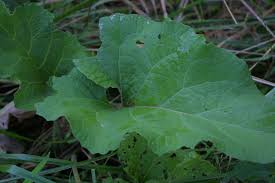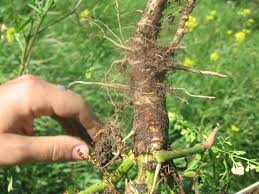I love eating my medicine. One of my favorite plants to forage is Burdock (Arcticum Lappa) because it happens to be both delicious and beneficial to almost all the major organs of the body. Burdock is rich in vitamins A, B, C, and E, as well as protein, iron, calcium, potassium, manganese, phosphorous, tannins, and fiber. Burdock’s action is most profound on the liver, making it one of the best blood purifiers in nature. It also works with lymph, sweat and oil glands, as well as on the lungs, kidneys, stomach, uterus, and joints. Take note that Burdock is not for people in hurry, it works slow and thoroughly as a cleanser and tonic.
Burdock has a high inulin content, and can comprise up to 50% of the plant’s total mass. Inulin is a prebiotic; it is not digested or absorbed in the stomach and goes to the bowels where bacteria are able to use it to grow. It supports the growth of healthy bacteria, improving digestion and absorption of nutriments. Inulin decreases the body’s ability to make certain kinds of fats and is a valuable substance for people with blood sugar issues as it may act as a buffer, preventing blood glucose levels from fluctuating erratically.
Let’s look at its many properties. Burdock is an alterative, which speaks to its ability to promote a gradual and beneficial change. It is anti-inflammatory, aphrodisiac, astringent, antiscorbutic (counter acts vitamin C deficiencies), bacteriostatic (stops bacteria from reproducing), carminative (relieves gas), demulcent (soothes irritations), diuretic, fungistatic (stops spread of fungal infections), nutritive tonic, and rejuvenative. Its ability to move waste can be noted by its antipyretic (cools fevers), diaphoretic (promotes sweating), febrifuge (reduces fevers) actions.
I think Jim McDonald captures Burdock’s essence beautifully.
“Running throughout the physical actions brought about by the use of Burdock are the themes of normalization and the restoration of balance. Burdock does not force its virtues upon us; it simply aids us in recovering our own when we lose touch with our well-being and fall into imbalance. It understands the importance of slow and subtle resolve and the benefits of gentle but consistent action. In the wild, Burdock grows on disturbed and injured soil, drawing nutrients from deep within the ground to replenish and heal the disturbed earth. It performs this same healing for us, drawing our own medicines from deep within our being to restore the conditions necessary for healing to occur. By recognizing such themes, we can better understand the use of an herb, and when it is indicated as a remedy for ourselves or another.”
Burdock is one of those special kinds of plants that offer both nutrition and healing benefits. Though western cuisine has largely ignored this wonderful herb, the Japanese truly appreciate Burdock as a wholesome, medicinal food – they even produce it commercially and sell it at market under the name of ‘Gobo’. The key to its popularity among the Japanese may lie in the well-kept secret of Burdock’s lesser known qualities: It is rumored that Burdock gives strength and endurance, especially with regard to sexual stamina. This has earned it a reputation as an aphrodisiac. However, it is important to note that the fresh herb/root is infinitely more powerful than the dried material. Fortunately, finding wild burdock, or even cultivating it yourself, is very easy.
I use Burdock roots and stems mainly in soups. Because of the high inulin content, it is important to cook it well. Be forewarned: inulin can cause excessive gas if not cooked thoroughly.

First year Burdock growth
Harvesting Burdock When you decide to make use of the roots, leaves, stems, and seeds of the Burdock plant, it is important that you harvest them during its peak. Roots, when all the vital energy is most concentrated within and being sent down into the roots ~ before the plant’s stems and flowers have developed. Collect the aerial parts while the vital energy is rising, but before flowers develop. Finally, the seeds after the plant have finished its growing process and starting to go back to the earth.
Burdock is a biennial plant, meaning it takes two years to complete its life cycle. It can grow more than 5 feet tall and its huge, expansive, heart-shaped leaves can reach over a foot in length. Burdock certainly ranks among the tallest and most space consuming herbs, sporting extraordinarily big leaves as well as the stickiest burrs.
First year plants have a rosette of large dusky green, heart-shaped leaves with a gray fine wooly mass down underneath. First year Burdock resembles and is often mistaken for rhubarb, so get out your field guide and make sure you identify it properly. It has a long tapering root with a white inner pith. In its second year, the plant grows to a large size, measuring from 3 to 7 feet in height. The stem is round, fleshy, and with many branches. The lower branches frequently measure 18 inches in length. The flowers are purple, in small-clustered heads armed with hooked spines, and the spiny burrs formed attach themselves to clothing and the hair of animals. The lower leaves are very large, on long, solid footstalks. They are furrowed above and frequently more than a foot long. The upper leaves are much smaller, more egg-shaped in form and not so densely clothed beneath with the grey down.

Burdock root
Harvesting Roots
You want to harvest first year roots in the fall or the following spring before stems start to develop. A 4-tine spading fork is your best friend for removing the plant roots from the soil. Susun Weed suggests that it is best to start on the east side of the plant, and then move around the plant, working the spading fork at each of the four directions. Plunge the spading fork in and rock it back and forth, continue until you have loosened the soil all around the root and then use a small spade to remove the loosen soil. As a rule, the roots are 12 inches or more in length and about 1 inch thick, sometimes, however, they extend 2 to 3 feet, making it necessary to dig by hand. Some suggest peeling the root, but I find simply scrubbing the soil off the root until I get to the root white, works just fine. They are delicious in soups and stews.
Harvesting Stems
Like the roots, you want to harvest the stems when they are most concentrated with the plant’s vital energy: before the flower develops. The outside of the stems have a bitter taste, so peel the green outside until you get to the white center. I soak the inner white stems in a cold-water bath and change the water several times to remove any bitter residue, so what is left is a sweet inner stem. Take a nibble to test to see if all the bitterness has been removed.The stems can be chopped up and added raw to salads, or cooked in soups and stews.
Debbie’s Nourishing Root Soup
(portions are up to you and how much you want to make)
- Dig up equal amounts of Burdock and Dandelion root (Taraxacum officinale) (keep Dandelion leaves but compost Burdock’s) you can also use Burdock stems instead of the root.(It is important to harvest equal amounts of dandelion and burdock. Eaten alone Burdock encourages the body to cleanse the body’s toxins through the skin, but when combined with Dandelion, toxins are released through urine. I think it is a much better way to eliminate toxins. Since, if you have too many toxins being released through your skin, it may result in pustules ~ yuck. Please never forget to add Dandelions when eating Burdock.)
- Harvest Stinging Nettles (Uritica dioica)
- Sauté chopped Onions in Olive Oil. When Onions are translucent add lots of chopped Garlic (at least 5 cloves) and wait a couple minutes
- Add peeled and chopped Ginger root, wait a couple minutes
- Add chopped Shitake mushrooms, wait a couple minutes
- Add 1 – 2 tsp Turmeric powder (use fresh if you can find it)
- After a couple of minutes add broth (veggie or chicken) or water (4 – 6 cups)
- Add chopped roots: Burdock, Dandelion, Beets (keep tops for later), Carrots, Sweet Potato, Potato, Turnip, or whatever floats your boat (I like to add sweet veggies to balance the bitterness of the Dandelion)
- Simmer for at least 45 mins.
- Add chopped Stinging Nettles, Dandelions & Beet greens
- Simmer for 15 mins.
- Put in blender or not (I blend it so Mathew eats it without picking out veggies but it tastes great either way)
- Add 1 tsp. of miso to bowl
- Pour soup over miso
- Add hot pepper to taste
ENJOY!
All information is shared for educational purposes only and has not been evaluated by the Food and Drug Administration. This information is not intended to diagnose, treat, cure, or prevent any disease.
Like this:
Like Loading...
 I am reminded of a bump sticker that I had on my car in the 80s, “If You’re Not Outraged, You’re Not Paying Attention.” And folks, it’s hard not to pay attention nowadays, since social media has put us in touch with every fact or alternative fact, every minute of every day. It is important to be well informed, but our lives are overwhelmed with information. It’s emotionally and physically exhausting; talk about information overload. During times like these, it is important to simply walk away and refuel, nourish our bodies and souls so we can continue to fight the good fight another day. Because it looks like we are in for a marathon. I know it is getting harder, to walk away as there are so many fights on so many fronts happening simultaneously. But it is important to refuel and nourish our bodies.
I am reminded of a bump sticker that I had on my car in the 80s, “If You’re Not Outraged, You’re Not Paying Attention.” And folks, it’s hard not to pay attention nowadays, since social media has put us in touch with every fact or alternative fact, every minute of every day. It is important to be well informed, but our lives are overwhelmed with information. It’s emotionally and physically exhausting; talk about information overload. During times like these, it is important to simply walk away and refuel, nourish our bodies and souls so we can continue to fight the good fight another day. Because it looks like we are in for a marathon. I know it is getting harder, to walk away as there are so many fights on so many fronts happening simultaneously. But it is important to refuel and nourish our bodies.
